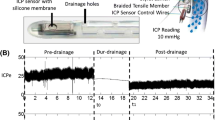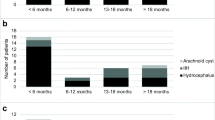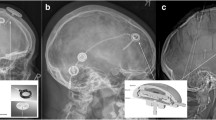Abstract
Introduction
LiquoGuard is a new device for intracranial pressure (ICP)-controlled drainage of cerebrospinal fluid (CSF). This present study evaluates the accuracy of ICP measurement via the LiquoGuard device in comparison with Spiegelberg. Thus, we compared data ascertained from simultaneous measurement of ICP using tip-transducer and tip-sensor devices.
Material and Methods
A total of 1,764 monitoring hours in 15 patients (range, 52–219 h) were analysed. All patients received an intraventricular Spiegelberg III probe with the drainage catheter connected to the LiquoGuard system. ICP reading of both devices was performed on an hourly basis. Statistical analysis was done by applying Pearson correlation and Wilcoxon-matched pair test (p < 0.05).
Results
Mean ICP values were 11 ± 5 mmHg (Spiegelberg) and 10 ± 7 mmHg (LiquoGuard); the values measured with both devices correlated well (p = 0.001; Pearson correlation =0.349; n = 1,764). In two of the 15 patients with slit ventricles, episodes of significant differences in measured values could be observed. Both patients suffering from slit ventricles failed to produce reliable measurement with the external transducer of the LiquoGuard.
Conclusions
LiquoGuard is a valuable new device for ICP-controlled CSF drainage. However, LiquoGuard tends to provide misleading results in slit ventricles. Thus, before these drawbacks are further analysed, the authors recommend additional ICP measurement with internal tip-sensor devices to avoid dangerous erroneous interpretation of ICP data.








Similar content being viewed by others
References
Açikbaş SC, Akyüz M, Kazan S, Tuncer R (2002) complications of closed continuous lumbar drainage of cerebrospinal fluid. Acta Neurochir 144:475–480
Brain Trauma Foundation, American Association of Neurological Surgeons, Joint Section on Neurotrauma and Critical Care: Critical pathway for the treatment of established intracranial hypertension (2000) J Neurotrauma 17:537–538
Bullock R, Chesnut RM, Clifton G, Ghajar J, Marion DW, Narayan RK (1996) Guidelines for the management of severe head injury. Brain Trauma Foundation. Eur J Emerg Med 3:109–127
Caruselli G, Recchioni MA, Occhipinti C, Bernardini M, Caruselli M (1992) The role of CSF ventricular drainage in controlling intracranial hypertension in patients with brain lesions. Comparison of three methods. Preliminary results. J Neurosurg Sci 36:219–225
Cao M, Lisheng H, Shouzheng S (1984) Resolution of brain edema in severe brain injury at controlled high and low intracranial pressures. J Neurosurg 61:707–712
Chambers IR, Siddique MS, Baniser K, Mendelow AD (2001) Clinical comparison of the Spiegelberg parenchymal transducer and ventricular fluid pressure. J Neurol Neurosurg Psychiatry 71(3):383–5
Czosnyka M, Czosnyka Z, Pickard JD (1996) Laboratory testing of three intracranial pressure microtransducers: technical report. Neurosurgery 38:219–224
Czosnyka M, Pickard JD (2004) Monitoring and interpretation of intracranial pressure. J Neurol Neurosurg Psychiatry 75:813–821
Eide PK, Sorteberg W, Meling T, Jörum E, Hald J, Stubhaug A (2007) From intracranial pressure to intracranial pressure wave-guided intensive care management of a patient with an aneurysmal subarachnoid haemorrhage. Acta Anaesthesiol Scand 51(4):501–504
Eymann R, Schmitt M, Antes S, Shamdeen MG, Kiefer M (2012) Dynamics of cerebrospinal fluid flow in slit ventricle syndrome. Acta Neurochir Suppl 113:181–186
Fakhry SM, Trask AL, Waller MA, Watts DD (2004) IRTC Neurotrauma Task Force: Management of brain-injured patients by an evidence-based medicine protocol improves outcomes and decreases hospital charges. J Trauma 56(3):492–493
Feldman Z, Narayan RK (1993) Intracranial pressure monitoring techniques and pitfalls. In: Cooper PR (ed) Head injury, 3rd edn. Williams & Wilkins, Baltimore, pp 247–274
Freiman TM, Spiegelberg A (2008) Mounting device fro external cerebrospinal fluid drainage: the Freiburg Static. Acta Neurochir 150:1081–1085
Ghajar JB, Hariri RJ, Patterson RH (1993) Improved outcome from traumatic coma using only ventricular CSF drainage for ICP control. Adv Neurosurg 21:173–177
Ghajar J (1995) Intracranial pressure monitoring techniques. New Horiz 3(3):395–399
Gopinath SP, Robertson CS, Contant CF, Narayan RK, Grossman RG (1995) Clinical evaluation of a miniature strain-gauge transducer for monitoring intracranial pressure. Neurosurgery 36:1137–1140
Kanter MJ, Narayan RK (1991) Management of head injury. Intracranial pressure monitoring. Neurosurg Clin N Am 2:257–265
Kiefer M, Steudel WI (2002) Modern intracranial pressure measurement techniques. Basic principles and general practice. Unfallchirurg 105(7):578–586
Koskinen LD, Olivercrona M (2005) Clinical experience with the intraparenchymal intracranial pressure monitoring Codman microsensor system. Neurosurgery 56:693–698
Lavinio A, Menon DK (2011) Intracranial pressure: why we monitor it, how to monitor it, what to do with the number and what’s the future? Curr Opin Anaesthesiol 24(2):117–123
Martinez-Manas RM, Santamarta D, de Campos JM (2000) Camino intracranial pressure monitoring; prospective study of accuracy and complications. J Neuol Neurosurg Psychiatry 69:82–86
Maas AI, Dearden M, Teasdale GM, Braakman R, Cohadon F, Iannotti F (1997) EBIC-Guidelines for mangement of severe head injury in adults. European Brain Injury Consortium. Acta Neurchir 139:286–294
Mendelow AD, Teasdale GM (1983) Pathophysiology of head injuries. Br J Surg 70(11):6641–6650
Miller JD, Garibi J, Pickard JD (1973) A clinical study of intracranial volume pressure relationships. Br J Surg 60(4):316
Narayan RK, Kishore PR, Becker DP (1982) Intracranial pressure: to monitor or not to monitor? A review of our experience with severe head injury. J Neurosurg 56:650–659
Palmer S, Bader MK, Qureshi A, Palmer J, Shaver T, Borzatta M (2001) The impact on outcomes in a community hospital setting of using the AANS traumatic brain injury guidelines. Americans Associations for Neurologic Surgeons. J Trauma 50(4):657–664
Papo I, Caruselli G, Luongo A (1981) CSF withdrawal for the treatment of intracranial hypertension I acute head injuries. Acta Neurochir 56:191–199
Piper I, Barnes A, Smith D, Dunn L (2001) The Camino intracranial pressure sensor: is it optimal technology? An internal audit with a review of current intracranial pressure monitoring technologies. Neurosurgery 49:1158–1165
Rickels W, von Wild K, Wenzlaff P (2010) Head injury in Germany: A population-based prospective study on epidemiology, causes, treatment and outcome of all degrees of head-injury severity in two distinct areas. Brain Inj 24(12):1491–1504
Staykov D, Speck V, Volbers B, Wagner I, Saake M, Doerfler A, Schwab S, Bardutzky J (2011) Early recognition of lumbar overdrainage by lumboventricular pressure gradient. Neurosurgery 68(5):1187–1191
Shore PM, Thomas NJ, Clark RS, Adelson PD, Wisniewski SR, Janesko KL (2004) Continuous versus intermittent cerebrospinal fluid drainage after severe traumatic brain injury in children: effect on biochemical markers. J Neurotrauma 21:1113–1122
Zhong J, Dujovny M, Park HK, Perez E, Perlin AR, Diaz FG (2003) Advances in ICP monitoring techniques. Neurol Res 25(4):339–350
Acknowledgments
We thank Möller Medical GmbH, Fulda, Germany for the on-loan appropriation of two LiquoGuard systems for the study, and Sam Orie, MD for editing support.
Conflicts of interest
None.
Author information
Authors and Affiliations
Corresponding author
Additional information
Comment
The present study shows that a closed drainage system, where unintentional underdrainage and overdrainage is avoided, is prone to erroneous ICP measurements when the ventricles are slit. If these cases are omitted, the system gives reliable and comparable ICP measurements compared to a traditional system with an open drainage catheter and pressure monitor.
Peter Siesjo
Lund, Sweden
The LiquoGuard device is undoubtedly interesting for its particular capability of controlled CSF drainage, but is not primarily intended to measure ICP. The present study evaluated it in this function.
When pressure is measured on the same channel as the draining one, physics impose the existence of certain interference by the drainage because this flow implies a supplementary pressure to generate it, which adds to the static pressure. As the LiquoGuard indeed performs simultaneous pressure measurement and drainage, its pressure measurement accuracy has to be critically evaluated, to determine its reliability and usefulness as an ICP monitor. Therefore, it has to be compared to an ICP measurement made without CSF drainage and the associated flow-induced pressure gradient.
In this study, the drainage channel of the Spiegelberg III was therefore connected to the LiquoGuard, and its independent ICP sensor was connected to the Spiegelberg. The close agreement between the Spiegelberg and the LiquoGuard found by this study is interesting and suggests that, in usual conditions, the CSF flow of the drained CSF does not interfere with the pressure measurement.
The different response in the setting of slit ventricles is, however, expected knowing the different designs of the systems, i.e. a single channel for pressure measurement and drainage for the LiquoGuard, as compared to separate channels for the Spiegelberg (the air pouch channel for pressure measurement is closed and independent of the CSF channel).
Thus, this study suggests that the original design of the LiquoGuard, with the pressure sensor mounted inline in front of the drainage pump, can be a robust ICP monitor, allowing, if necessary, a more controlled CSF drainage.
Shahan Momjian and Benedict Rilliet
Geneva, Switzerland
Portions of this work were presented in poster form at the 60th Conference of DGNC, Münster, Germany, 27 May 2009 and Hydrocephalus 2009, Baltimore, Maryland, USA, 2 September 2009.
Rights and permissions
About this article
Cite this article
Linsler, S., Schmidtke, M., Steudel, W.I. et al. Automated intracranial pressure-controlled cerebrospinal fluid external drainage with LiquoGuard®. Acta Neurochir 155, 1589–1595 (2013). https://doi.org/10.1007/s00701-012-1562-3
Received:
Accepted:
Published:
Issue Date:
DOI: https://doi.org/10.1007/s00701-012-1562-3




